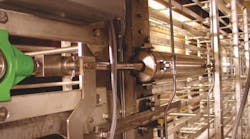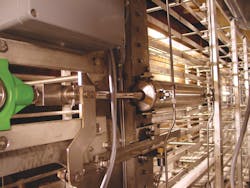In the early 1940s, Ray Townsend worked in his father's metalworking shop and occasionally asked to do custom fabrication at a local meat packing plant in Des Moines, Iowa. His observations there piqued his interest in the technology of meat processing machinery. As a result, he founded the Townsend Engineering Company.
Twenty years later, in 1962, Townsend Engineering introduced the first semi-automatic sausage linking machine. Since that time, due to Townsend's policy of continuous development, sausage making machines have incorporated many improvements. With their machines in use in more than 100 countries around the globe, Townsend Engineering has grown to become a highly respected developer and manufacturer of the world's most innovative food processing equipment.
Continuous sausage production machines from Townsend Engineering use Roundline stainless steel cylinders from Norgren. With their high reliability, long life, and hygienic design, these actuators are a logical choice because they also are easy to clean and tolerate wash-down with strong detergents.
Traditional casings eliminated
From its European headquarters in Oss, Netherlands, Townsend Engineering B.V. develops and manufactures continuous sausage production systems based on the co-extrusion principle. This is a recent and far-reaching development that opens up a new freedom in design, allowing high-speed continuous sausage production by eliminating the need for separate traditional tubular casings. Instead, the casing is in the form of a collagen fibre paste continuously made in a special process and extruded with the sausage.
Easy-to-clean air cylinders
Pneumatic cylinders applied to food processing machines are likely to come into close proximity with the product. For this reason, strict requirements exist to address corrosion resistance, non-toxicity, and non-absorbency of the materials of construction. Norgren's KM/55001/M series double-acting Roundline cylinders, constructed of stainless steel, have features that closely match the application's needs.
These cylinders are suitable for areas where food is processed according to HACCP / EN 1672-2. HACCP, Hazard Analysis Critical Control Point, assesses risk of contamination by identifying hazards that may affect the quality or safety of food products and controlling them at all stages of processing to minimize risks of product contamination.
The clean line shape of Roundline cylinders minimizes surface areas where contaminant could accumulate and makes the cylinders easy to clean. Corrosion-resistant materials help maintain a smooth surface and stand up to frequent wash downs. Each sausage processing system uses 64 of these cylinders: 40 with a 100-mm bore, 12 with a 40-mm bore, and 12 with a 32-mm bore.
Central lubrication
For long, trouble free life of pneumatic equipment, central lubrication is selected as the ideal solution when supplying compressed air through long or complex installation networks. This is achieved from a single Norgren Micro-fog lubricator mounted in a stainless steel cabinet.
The Micro-fog lubricator atomises oil droplets to produce an aerosol from which only particles smaller than 2 µm can enter the compressed air supply. These can be carried by the compressed air stream for more than 300 m.
A different kind of lubrication is required for the 700-m of conveyor chain typically found in these machines. This is accomplished via a centrally located Norgren Presslube system.
Information for this application was provided by IMI Norgren Ltd., Litchfield, England. Contact Norgren's U. S. headquarters, Littleton, Colo., at (303) 794-2611, or visit www.norgren.com.


